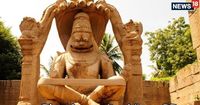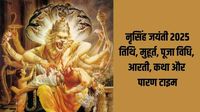Narasimha Jayanti, a significant festival in Hinduism, is celebrated to honor the fierce incarnation of Lord Vishnu, known as Bhagwan Narsingh. This year, the festival falls on May 11, 2025, coinciding with the Chaturdashi Tithi of Krishna Paksha in the month of Vaishakh, as per the Hindu calendar. The day symbolizes the triumph of good over evil and the protection of devotees, particularly the story of Bhagwan Narsingh protecting his ardent devotee Prahlad from the demon king Hiranyakashyap.
According to religious texts, Narasimha Jayanti marks the day when Lord Vishnu took the form of Narsingh, which is half man and half lion, to protect Prahlad. The significance of this day is deeply rooted in the belief that worshiping Narsingh can remove obstacles and fulfill the desires of his followers. The tradition of celebrating this day has been passed down through generations, and it is customary to exchange greetings and messages of goodwill.
On this auspicious occasion, devotees engage in various rituals and prayers. The evening puja is particularly important, with the auspicious time set from 4:21 PM to 7:04 PM on May 11, 2025. This timing is believed to be the most favorable for invoking the blessings of Lord Narsingh.
As per the legends, Hiranyakashyap, having received a boon from Brahma that made him nearly invincible, sought to be worshiped exclusively. His son, Prahlad, however, remained devoted to Lord Vishnu, which infuriated Hiranyakashyap. In a fit of rage, Hiranyakashyap tried various methods to kill Prahlad, but to no avail. It was during this crisis that Lord Vishnu manifested as Narsingh, emerging from a pillar to defeat the demon king.
The narrative describes how Narsingh killed Hiranyakashyap at dusk—neither day nor night—on the threshold of his house, thus circumventing the terms of the boon. This event is celebrated as a testament to the idea that faith in God can provide protection against all forms of evil.
As devotees prepare for the festivities, many choose to observe a fast, with some opting for a Nirjala Vrat (a fast without water). This fast typically concludes with the evening puja. The rituals include offering special dishes, known as Naivedya, which may consist of fruits, sweets, and roasted chickpeas, along with Tulsi leaves.
In preparation for the puja, devotees are advised to wear clean, preferably yellow or red clothes, and to purify their worship space with Ganga water. The idol or image of Lord Narsingh should be placed on a raised platform covered with red or yellow cloth. The idol is then bathed with Panchamrit, a mixture of milk, yogurt, ghee, honey, and sugar, before being adorned with flowers, incense, and a lamp.
Reciting the Narasimha Kavacham and other mantras like "Om Namo Bhagwate Narasinhaya" is also an essential part of the worship. Following the prayers, the story of Prahlad and Hiranyakashyap is recounted, reinforcing the moral lessons of the festival.
Devotees also engage in charitable acts on this day, often donating to the needy, especially in the hot month of Vaishakh. Offering water, juices, or fans to those in need is considered particularly auspicious.
As the day unfolds, many choose to participate in night vigils, singing devotional songs and prayers to seek blessings and strength from Lord Narsingh. The observance of Narasimha Jayanti is not merely a ritual; it is a reaffirmation of faith in the divine protection that comes from unwavering devotion.
In summary, Narasimha Jayanti is a vibrant celebration that highlights the eternal struggle between good and evil, reminding devotees of the protective power of faith and devotion. As the festival approaches, the spirit of celebration fills the air, with families and communities coming together to honor this significant day.






